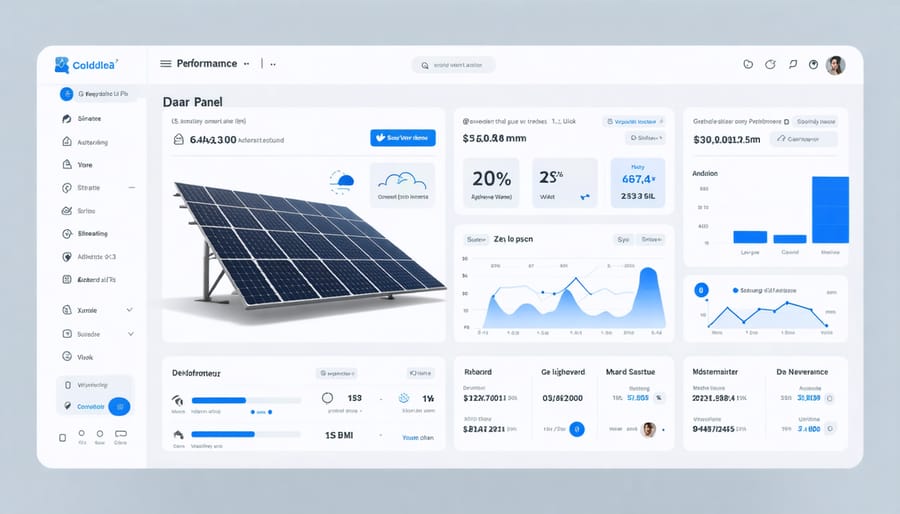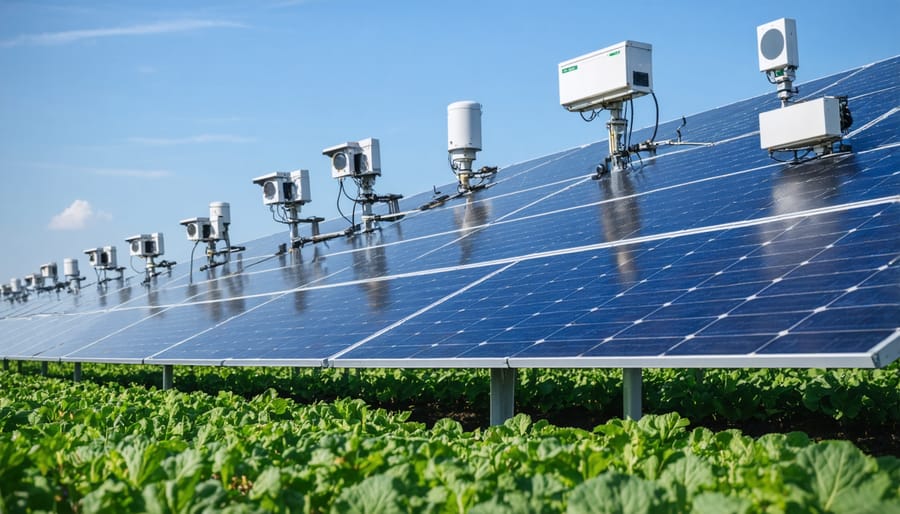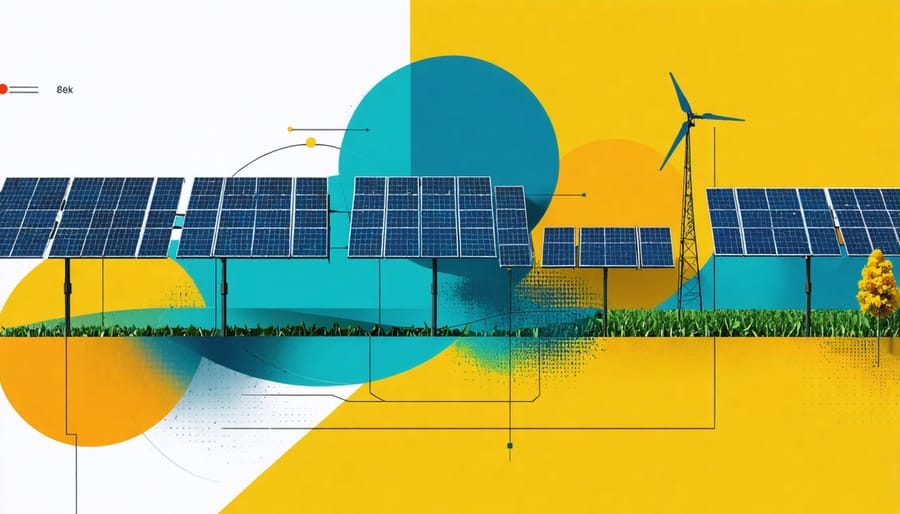Smart PV Monitoring Makes Your Solar-Powered Farm More Profitable

In today’s rapidly evolving energy landscape, PV monitoring systems serve as the backbone of efficient solar power management, transforming how we optimize and maintain photovoltaic installations. These sophisticated monitoring solutions have become indispensable for modern solar-powered agriculture and industrial applications across Europe.
Real-time performance tracking, automated fault detection, and predictive maintenance capabilities enable system owners to maximize energy yield while minimizing downtime. By continuously analyzing crucial parameters like power output, voltage levels, and environmental conditions, these intelligent monitoring platforms provide actionable insights that directly impact operational efficiency and return on investment.
Advanced PV monitoring systems now integrate seamlessly with smart grid technologies, enabling better energy management and storage optimization. For European businesses and homeowners, this translates into enhanced control over their solar assets, reduced maintenance costs, and improved system longevity. The ability to access system performance data remotely through secure cloud platforms has revolutionized how we approach solar energy management, making it more accessible and efficient than ever before.
How PV Monitoring Revolutionizes Agricultural Solar Systems
Real-time Performance Tracking
Real-time performance tracking forms the backbone of modern PV monitoring systems, delivering crucial insights into your solar installation’s operational efficiency. These sophisticated systems continuously collect and analyse data from multiple sensors, measuring key parameters such as power output, voltage levels, and energy yield at intervals as frequent as every few seconds.
Advanced monitoring platforms transform raw data into actionable intelligence through intuitive dashboards. They track daily energy production patterns, compare actual performance against expected yields, and instantly detect any deviations that might indicate potential issues. This proactive approach enables system owners to maintain optimal energy production levels and swiftly address any performance drops.
The monitoring system also analyses environmental factors, including solar irradiance, temperature, and weather conditions, to provide context-aware performance metrics. This comprehensive data collection helps differentiate between natural variations in output and genuine system inefficiencies, ensuring accurate performance assessment.
For maximum reliability, modern monitoring solutions feature automated alert systems that notify operators via mobile apps or email when performance falls below predetermined thresholds, enabling swift response to maintain system efficiency.

Weather Integration and Forecasting
Weather monitoring integration is a crucial component of modern PV monitoring systems, offering invaluable insights for optimising solar farm performance. Advanced weather stations installed alongside solar arrays collect real-time data on solar irradiance, ambient temperature, wind speed, and precipitation levels. This comprehensive weather data enables system operators to accurately forecast energy production and identify potential environmental impacts on panel efficiency.
The integration of weather monitoring capabilities allows for precise performance ratio calculations by comparing actual energy yield against theoretical maximum output based on current weather conditions. Farm operators can receive automated alerts when weather conditions might affect system performance, such as approaching storms or unusual temperature fluctuations.
Many contemporary PV monitoring platforms incorporate machine learning algorithms to analyse historical weather patterns alongside performance data, generating accurate energy yield predictions for the coming days or weeks. This predictive capability helps operators optimise maintenance schedules and grid feed-in strategies, ultimately improving overall system efficiency and revenue generation.
For agricultural applications, these weather insights prove particularly valuable, enabling farmers to coordinate their energy-intensive activities with periods of optimal solar production while maintaining stable power supply for critical operations.
Essential Components of Agricultural PV Monitoring Systems

Sensors and Data Collection Tools
Modern PV monitoring systems employ a diverse array of sensors and data collection tools to ensure optimal solar installation performance. At the heart of these systems are irradiance sensors, which measure solar intensity and help evaluate actual versus expected energy production. Temperature sensors monitor both ambient conditions and panel surface temperatures, crucial for understanding efficiency variations and potential performance issues.
Current and voltage sensors installed at various points throughout the system provide real-time electrical performance data. These components work alongside power meters that track energy production and consumption patterns with precision. Weather stations, incorporating additional sensors for wind speed, humidity, and precipitation, offer valuable contextual data for performance analysis.
String monitoring devices analyse the performance of individual panel groups, while inverter-integrated sensors provide detailed information about DC-to-AC conversion efficiency. Modern systems also feature smart junction boxes with built-in monitoring capabilities, offering granular performance data at the module level.
Data loggers serve as the central collection point, gathering information from all sensors and converting it into digital format. Many systems now incorporate smart IoT sensors that enable wireless data transmission and remote monitoring capabilities. These advanced tools often feature self-diagnostic capabilities, alerting operators to potential issues before they impact system performance.
For enhanced reliability, most installations include backup sensors and redundant monitoring systems, ensuring continuous data collection even if primary sensors experience issues.
Smart Analytics and Reporting Platform
The smart analytics platform serves as the brain of your PV monitoring system, transforming raw data into actionable insights through an intuitive interface. This sophisticated software solution enables real-time monitoring of your solar installation’s performance while integrating seamlessly with other smart agricultural solutions for comprehensive facility management.
The platform’s dashboard presents key performance indicators through customizable widgets, allowing you to track energy production, consumption patterns, and system efficiency at a glance. Advanced reporting tools generate detailed analyses of historical data, helping you identify trends and optimize system performance over time.
Built-in alert systems promptly notify you of any anomalies or maintenance requirements, ensuring minimal downtime and maximum system efficiency. The software’s predictive analytics capabilities leverage machine learning algorithms to forecast energy production and identify potential issues before they impact performance.
Data visualization tools present complex information in easily digestible formats, enabling informed decision-making for both technical and non-technical users. The platform supports multiple device access, allowing you to monitor your system from anywhere via desktop or mobile applications.
Export capabilities enable easy sharing of reports with stakeholders, while automated reporting features save time and ensure consistent performance tracking. Regular software updates ensure your platform remains current with industry standards and security requirements.

Integrating PV Monitoring with Crop Management
Unified Dashboard Solutions
Modern PV monitoring solutions have evolved to offer comprehensive dashboards that seamlessly integrate both solar energy and agricultural data monitoring. These unified platforms enable farmers and facility managers to view critical metrics from both operations in a single, intuitive interface. Real-time data streams combine solar production statistics, weather conditions, soil moisture levels, and crop health indicators, providing a holistic view of farm operations.
These integrated systems typically feature customisable widgets that allow users to prioritise their most important metrics. Farmers can track solar panel efficiency alongside irrigation schedules, while monitoring crop growth patterns and energy consumption trends. Advanced analytics tools process this combined data to identify correlations between solar production and agricultural productivity, helping optimise both operations simultaneously.
The latest dashboard solutions also incorporate mobile accessibility, enabling remote monitoring through smartphone applications. Push notifications alert users to important events, such as unexpected drops in solar production or critical changes in crop conditions. Many platforms now include AI-powered predictive analytics, forecasting potential issues before they impact either solar or agricultural operations.
This unified approach to monitoring has proven particularly valuable in agrivoltaic systems, where solar panels and crops share the same space, requiring careful balance and coordination of resources.
Optimization Strategies
Effective PV monitoring data analysis enables farm managers to implement strategic improvements across their operations. By tracking performance metrics in real-time, operators can identify opportunities to boost crop yields with agrivoltaics while maximizing energy production.
Key optimization strategies include establishing performance baselines for different seasons and weather conditions, then using this data to adjust panel tilt angles and cleaning schedules. Regular analysis of energy generation patterns helps identify optimal times for irrigation and other power-intensive farming activities.
Implementing predictive maintenance schedules based on monitoring data helps prevent system downtime and extends equipment lifespan. Operators can also use historical performance data to fine-tune panel spacing and positioning, balancing solar energy capture with crop shading requirements.
For maximum efficiency, integrate monitoring insights with smart irrigation systems and automated climate control. This coordinated approach ensures optimal resource utilization while maintaining ideal growing conditions. Regular review of monitoring reports enables continuous system refinement, leading to improved overall farm productivity and sustainability.
Remember to document all optimization measures and their results, creating a valuable knowledge base for future improvements and system expansion planning.
Implementation and ROI
Implementing a PV monitoring system requires careful planning but offers substantial returns on investment when executed properly. The initial setup typically involves three key phases: hardware installation, software configuration, and team training. For most European installations, the implementation process takes between 2-4 weeks, depending on system size and complexity.
The hardware components, including sensors and data loggers, should be installed by certified professionals to ensure optimal performance and compliance with EU regulations. Software setup follows, with customization of monitoring parameters and alert thresholds to match specific operational needs. Staff training is crucial for maximizing system benefits and ensuring proper maintenance.
Investment costs vary based on system size and features, typically ranging from €2,000 for small residential installations to €15,000+ for large commercial systems. However, the ROI timeline is compelling – most systems pay for themselves within 2-3 years through various benefits:
• Increased energy yield (5-12% improvement)
• Reduced maintenance costs (up to 30%)
• Extended system lifespan
• Lower insurance premiums
• Enhanced warranty compliance
To maximize solar field profits, proper monitoring is essential. Studies show that advanced monitoring systems can detect and prevent issues that would otherwise reduce system efficiency by up to 20%. The combination of preventive maintenance and optimized performance typically results in annual savings between €0.02-0.04 per installed watt.
For optimal results, consider working with experienced system integrators who understand local conditions and regulations. Many providers offer flexible financing options, making advanced monitoring solutions accessible to installations of all sizes while ensuring rapid return on investment.
PV monitoring systems have proven to be game-changing tools for modern agricultural operations across Europe. By providing real-time insights into solar energy production alongside crop monitoring capabilities, these systems enable farmers to optimize both energy efficiency and crop yields. The integration of smart monitoring solutions has demonstrated significant cost savings while supporting sustainable farming practices.
Looking ahead, the future of PV monitoring in agriculture appears promising, with emerging technologies like artificial intelligence and IoT sensors further enhancing system capabilities. We can expect to see more sophisticated prediction models, improved automation features, and seamless integration with other smart farming solutions. As European agriculture continues to embrace digital transformation, PV monitoring systems will play an increasingly crucial role in achieving both environmental sustainability goals and operational excellence.
For farmers considering implementation, the initial investment in PV monitoring technology consistently delivers substantial returns through reduced energy costs, improved crop management, and increased operational efficiency.
Leave a Reply